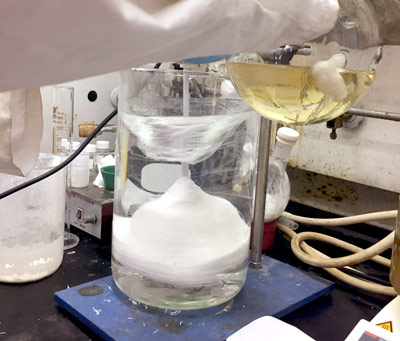
A team of researchers has developed a faster and easier way to make sulfur-containing polymers that will lower the cost of large-scale production.
The achievement, published in Nature Chemistry and Angewandte Chemie, opens the door to creating new products from this class of polymers while producing far less hazardous waste. The researchers’ reaction technique, dubbed SuFEx for sulfur(VI) fluoride exchange, combined with a newly identified class of catalysts that speed up the reactions, could be used to make everything from water bottles and mobile phone cases to medical devices and bulletproof glass.
Molecular Foundry scientists worked with a team led by Nobel Laureate K. Barry Sharpless and Peng Wu, professors at the Scripps Research Institute (TSRI). The team created long chains of linked sulfur-containing molecules, termed polysulfates and polysulfonates, using a SuFEx click reaction.
The SuFEx reaction, introduced as a new family of click reactions in 2014, reliably and quickly creates new chemical bonds, connecting compounds together with sulfates or sulfonates. While polysulfates have shown great potential as competitors to polycarbonates (strong plastics used for eyewear lenses and water bottles, for example), they have been rarely used for industrial applications due to a lack of reliable and easily scalable synthetic processes.
To overcome the challenges of mass-manufacturing polysulfates and polysulfonates, the TSRI team explored various catalysts and starting reagents to optimize the SuFEx reaction. They relied on their collaborators at the Molecular Foundry to assess physical properties and determine if the newly created polymers were thermally stable products.
Polymers are assembled from smaller molecules – like stringing a repeating pattern of beads on a necklace. In creating a polysulfonate “necklace” with SuFEx, the researchers identified ethenesulfonyl fluoride-amine/aniline and bisphenol ether as good “beads” to use and found that using bifluoride salt as a catalyst made the previously slow reaction “click” into action. Researchers found that the high efficiency of the reaction results in a remarkable 99 percent conversion, from starting reactants to products, in less than an hour.
Researchers also found that the new reaction requires 100 to 1,000 times less catalyst than other known methods, resulting in significantly less hazardous waste. Bifluoride salts are also much less corrosive than previously used catalysts, allowing for a wider range of starting substrate “beads,” which researchers said they hope could lead to its adoption for a range of industrial processes.

